We may not have the course you’re looking for. If you enquire or give us a call on +44 1344 203 999 and speak to our training experts, we may still be able to help with your training requirements.
Training Outcomes Within Your Budget!
We ensure quality, budget-alignment, and timely delivery by our expert instructors.
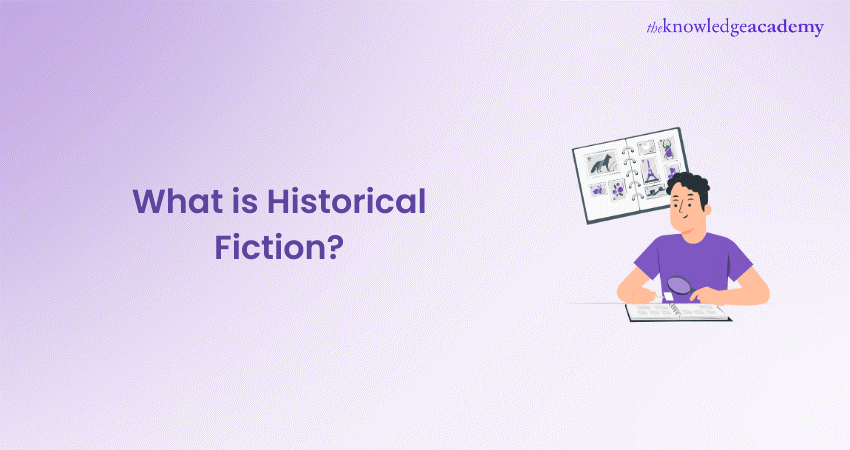
What if the allies and enemies switched places during World War II? What if a famous political figure of our era was transported to ancient Egypt? What if you and Shakespeare collaborated on an epic poem? Welcome to the world of historical fiction, where facts and imagination strike the perfect creative balance! This literary style weaves fictional characters and events into real historical settings for a seamless display of storytelling excellence and reading experience.
But what goes into crafting a story like this? What are the essential elements you must keep in mind before getting started? Wonder no more as this blog explores What is Historical Fiction in exquisite detail, including famous examples to get you inspired. So, dive in, unlock your literary side and transport your readers through the pages of history and your imagination!
Table of Contents
1) What is Fiction?
2) What is Historical Fiction?
3) Important Features of Historical Fiction
4) Fascinating Facts About Historical Fiction
5) Different Types of Historical Fiction
6) Five Essential Elements of Historical Fiction
7) Tips for Crafting Historical Fiction
8) Selecting Historical Fiction Books for Children
9) Conclusion
What is Fiction?
Fiction is any literature rooted from the power of great imagination that typically has a narrative. It describes imaginary people and events and usually comes in the form of books and stories. The main goal of fiction is to entertain and inspire the readers. Fiction transports you into imaginary worlds and introduces you to characters as well as their growth and transformation. It offers an insight into lives the readers would never have the chance to witness otherwise.
What is Historical Fiction?
Historical fiction is a literary genre in which the story takes place in the past. Historical novels capture the details and essence of the time period being explored as accurately as possible for authenticity, including social norms, customs, manners, and traditions. Numerous novels in this genre tell fictional stories involving actual historical figures or events. Essentially, historical fiction combines crucial elements of fiction and non-fiction narratives.
Important Features of Historical Fiction
These are the most important features of historical fiction:
1) Accurate Historical Settings: The most vital feature of historical fiction is a historically accurate setting. This may be a specific event, year, or notable period identifiable by its unique social norms and experiences. Examples of settings you could use in historical fiction include London in the 1920s or the UK during World War II. These historically accurate settings and dates differentiate historical fiction from other genres.
2) Creative Plot with Historical Themes: Fantasy and imagination are essential ingredients of historical fiction. A creative plot that combines fictional events with historical events of the time is a vital feature. For example, the novel 'The Book Thief' by Markus Zusak follows the life of a young girl who's a passionate reader set in Nazi Germany during World War II.
3) Colourful Characters Living in the Chosen Time: Similarly to the plot features of historical fiction, the characters in historical fiction can be fictional, real or both. While it's okay to let your imagination run wild with fictional characters, they must all speak, look, and act in ways reflective of the era.
4) Historically Accurate Speech Patterns and Dialogue: The speech and behavioural patterns must reflect the traditions of that real-time period. They should spotlight the status and class of the characters speaking in the story. For example, characters in the 1920s UK would not use modern-day American slang words and also wouldn't reference current technologies.
Fascinating Facts About Historical Fiction
Here are some facts about historical fiction that might pique your interest:
1) Sir Walter Scott’s Waverley, published in 1814, is deemed the first historical fiction novel. The story is set in 1194, near the end of the Crusades, when the titular hero returns to England only to find himself disinherited for falling in love with the wrong woman.
2) Some critics argue that historical fiction dates back to 800 B.C., to Homer's The Odyssey and The Iliad.
3) While the idea of historical fiction is flexible, many say that the book's events must take place at least 50 years before the reader's current time.
4) Historical fiction, as known in contemporary Western literature, dates back to the early 19th century. James Fenimore Cooper, Leo Tolstoy and Sir Walter Scott were among the first novelists to explore historical settings as a concept.
Different Types of Historical Fiction
While every work of historical fiction must be set in the past, there's still lots of freedom and flexibility to play with in terms of form and themes. Here's a list of the various types of historical fiction
1) Documentary Fiction
Documentary fiction (also known as docufiction) is the cinematographic combination of fiction and documentary. This film genre's goal is to capture reality as it is while introducing fictional elements into the narrative.
2) Historical Fantasy
Historical fantasy equips authors with the freedom to change specific details of the past while holding onto others. For instance, ‘Outlander’ written by Diana Gabaldon, tells the story of Claire Randall, a nurse working during World War II who finds herself transported back in time to 18th-century Scotland.
3) Historical Romance
Historical romance narrates love stories set in the past. 'Gone with the Wind' by Margaret Mitchell is a famous example which follows a young woman and widow named Scarlett O’Hara during the Civil War.
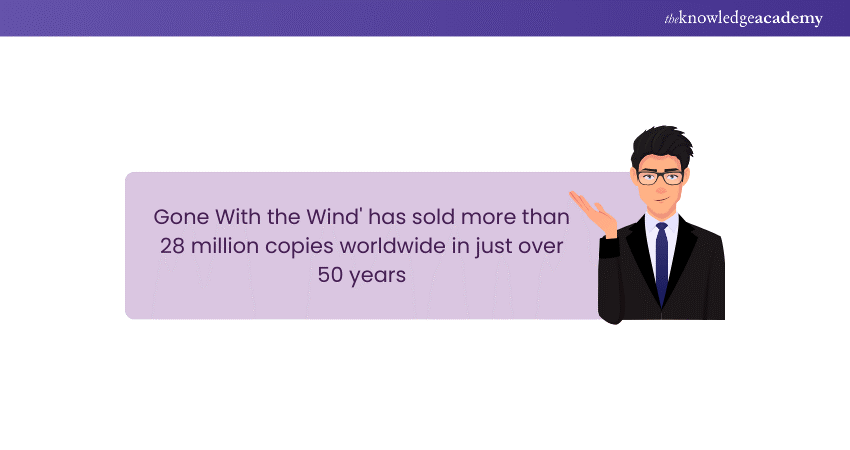
4) Historical Series and Epics
These are narratives that encompass several eras, often in many different settings. For instance, Frank Delaney's 'Ireland' covers all the tales historically significant to the country, from ancient kings to 20th century triumphs.
5) Biographical Historical Fiction
This subgenre recounts a fictionalised story of a real person's life. Biographical historical fiction can also narrate stories about a specific group of people. A good example is Charles Johnson’s 'Middle Passage,' which details the horrors of the slave trade.
6) Historical Mysteries and Thrillers
This style shares the themes and tropes of contemporary mystery and thriller genres, but the main difference is that it is set in the past. A fascinating example is ‘The Mystery of Mrs. Christie’ by Marie Benedict. This is a fictionalised account of the real disappearance of the famous detective fiction author Agatha Christie.
7) Historical Adventures
These stories describe journeys, such as Homer's 'Odyssey', which details the past victories of the Greek hero. Another great example of this style is ‘The Three Musketeers’ by Alexandre Dumas which is set in 17th century France and relates the adventures of d’Artagnan and his three friends, the musketeers Athos, Porthos, and Aramis.
Looking to hone your skills in crafting inventive stories and characters? Our Fiction Writing Course will help you out – Register now!
Five Essential Elements of Historical Fiction
To craft a work of historical fiction, some elements are essential to its foundation. These elements ensure that the story doesn’t sway from its intended purpose. Let’s explore these elements in detail:
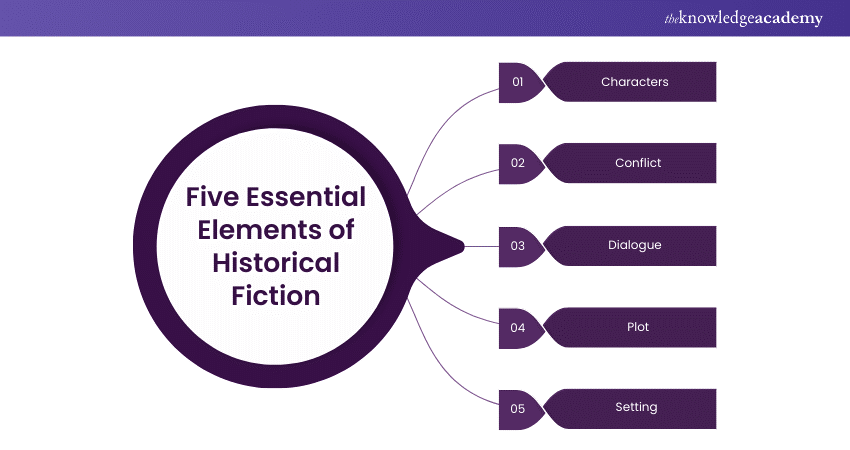
1) Characters
The characters in historical fiction can be real, fictional, or both, but their actions, looks and speech patterns must accurately reflect the era. For example, if one is writing a book about Mary Tudor, her family history as the sister to Elizabeth I or the daughter of Henry VIII mustn't be reinvented or disregarded.
2) Conflict
The problems the characters encounter in the story must be conflicts real people of that era encountered. For instance, a book could depict the hesitation and fear of a German soldier as he faces deployment to the Eastern Front, because of the awareness that he’s likely marching toward his death.
3) Dialogue
The dialogue must be authentic to the period and must reflect the speaking characters' status. For example, British soldiers in the Revolutionary War would not use modern Western slang.
4) Plot
The plot in a work of historical fiction is a combination of real and fictional events. While characters, cities, and events can be invented, they still must make sense to the time period. For example, a novel set in London in 1666 would benefit greatly from incorporating the Great Fire of London.
5) Setting
The setting is the most vital part of historical fiction, and it must occur during an authentic period in history and in a real-world place. Examples include Poland during World War II or New York City during the Great Depression.
Master advanced techniques in creating engaging and persuasive content through our Copywriting Course - Sign up now!
Tips for Crafting Historical Fiction
Now that you’ve explored the essential features, components and categories of historical fiction, it’s time for some expert tips. The tips listed below will help you get started and create a momentum for your writing.
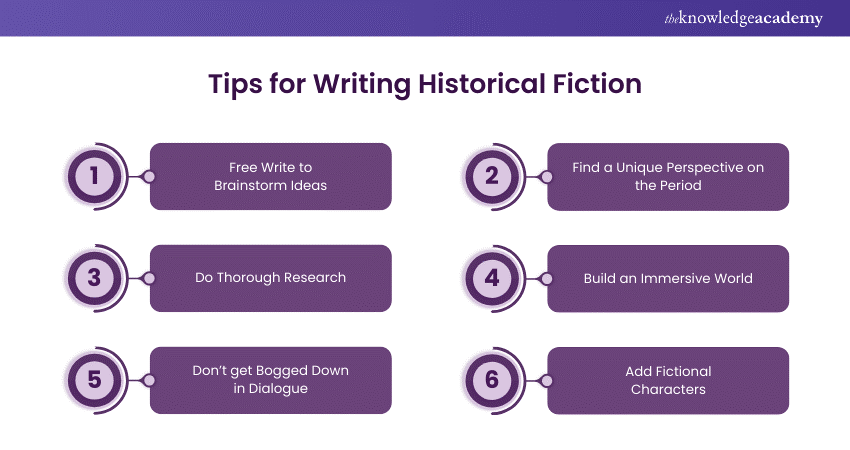
1) Create an Immersive World
Immersive World-building makes historical fiction more authentic and gives readers a reason to keep revisiting. The details of the world must provide readers with some historical context and balance it with familiar, relatable details to keep the story grounded. However, it's advisable not to add information just to fill pages. Every part of the world-building must advance the story.
2) Introduce Fictional Characters
Even if you are writing about true events, creative liberties are more than welcome. Introducing fictional characters to complement actual historical figures can help you drive the story along, inject genuine personality, and keep it entertaining.
3) Avoid Overly Complex Dialogue
Different historical eras contain different vocabulary and grammatical structures. While you must include occasional words and phrases to reinforce the historical setting, don’t include so many that the novel becomes a chore to read.
4) Conduct Thorough Research
On top of getting the historical facts right, the smaller details are vital too. You can write an inventory of the details that you haven’t researched but should check. Likely, these will be small things such as colour of buildings during those times or how much a stable boy earned in medieval times. Such accuracy will keep a reader interested and lend greater credibility to the story.
5) Discover a Unique Perspective on the Period
You can consider using a historical time period as a backdrop and putting fictional characters within that world. Conversely, you can choose a fictional event and put real-world historical characters in it. In case of a series, you can bring the fictional and real-world characters together in a later instalment to create more excitement.
Use Free Writing to Generate Ideas
If you’re keen on writing historical fiction but don’t know where to begin, here's something you must try: Spend 15 minutes on your notebook writing about a time period or historical event that interests you. Note any assumptions you may have about the period, cultural depictions of it from other books and movies, and what precisely fascinates you about this moment in history.
Explore the craft of speedwriting in our detailed Speed Writing Course - Register now!
Selecting Historical Fiction Books for Children
Learning about and reading historical fiction is a powerful way to engage children in both literacy skills and historical events. It helps them interpret events that occurred at a time far removed from their own life experience. Here are some perfect pieces of historical fiction for kids:
1) Journey of the Pale Bear by Susan Fletcher: Based on a true story, this book relates the tale of a polar bear sent by the King of Sweden as a gift to the King of England. In it, the character Arthur is put in the bear’s cage as punishment, but the two become friends and go on an exciting but perilous journey to the bear’s new home.
2) Private Peaceful by Michael Morpurgo: Told from the perspective of Private Tommo Peaceful, this book follows the 24 hours he spent at the frontline during WW1, and captures his memories of his family and his village life.
3) The Bicycle Spy by Yona Zeldis McDonough: The story follows bicycle-loving Marcel who's upset about the Nazi invasion of France cancelling the Tour de France. Then he finds himself in a position where he must make a dangerous bicycle journey to pass important information.
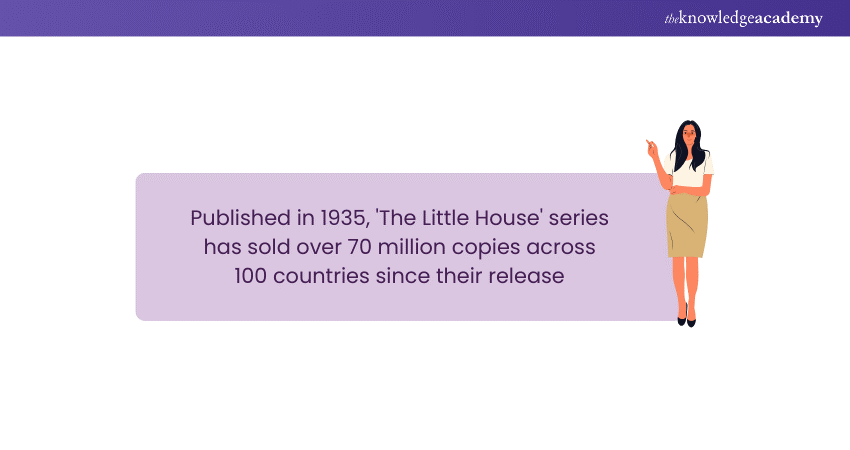
4) Little House on the Prairie by Laura Ingalls Wilder: Based on the author’s own life, the story follows the story of the Ingalls family. In it, they leave their little house in the Big Woods of Wisconsin and travel to Kansas with the hope of building a new home.
Conclusion
In conclusion, historical fiction offers a unique journey through time, as it blends the richness and intensity of real history with the creativity of storytelling. This literary genre provides endless possibilities whether you're a reader seeking a new reading experience or an aspiring writer itching to bridge fact and fiction. Understanding What is Historical Fiction, as explored in this blog, will help you craft an authentic historical narrative without compromising on your imagination's boundaries.
Expand your Creative Writing skills and learn to overcome storytelling challenges in our comprehensive Creative Writing Course – Sign up now!
Frequently Asked Questions

By exploring fictional stories set in real historical events, readers can expand their understanding of the past and gain insight into diverse cultures and societies. Historical fiction allows you to do that in an entertaining way.

Numerous themes can be explored in historical fiction, including:
a) Heroism
b) Hope
c) Coming of age
d) Death and loss
e) Friendship
f) Patriotism
g) Deception

The Knowledge Academy takes global learning to new heights, offering over 30,000 online courses across 490+ locations in 220 countries. This expansive reach ensures accessibility and convenience for learners worldwide.
Alongside our diverse Online Course Catalogue, encompassing 19 major categories, we go the extra mile by providing a plethora of free educational Online Resources like News updates, Blogs, videos, webinars, and interview questions. Tailoring learning experiences further, professionals can maximise value with customisable Course Bundles of TKA.

The Knowledge Academy’s Knowledge Pass, a prepaid voucher, adds another layer of flexibility, allowing course bookings over a 12-month period. Join us on a journey where education knows no bounds.

The Knowledge Academy offers various Personal Development Courses, including the Creative Writing Course and the Journalism Course. These courses cater to different skill levels, providing comprehensive insights into World Book Day.
Our Business Skills Blogs cover a range of topics related to creative writing, offering valuable resources, best practices, and industry insights. Whether you are a beginner or looking to advance your writing skills, The Knowledge Academy's diverse courses and informative blogs have got you covered.
Upcoming Business Skills Resources Batches & Dates
Date
 Fiction Writing Masterclass
Fiction Writing Masterclass
Fri 21st Feb 2025
Fri 25th Apr 2025
Fri 20th Jun 2025
Fri 22nd Aug 2025
Fri 17th Oct 2025
Fri 19th Dec 2025







 Top Rated Course
Top Rated Course



 If you wish to make any changes to your course, please
If you wish to make any changes to your course, please


